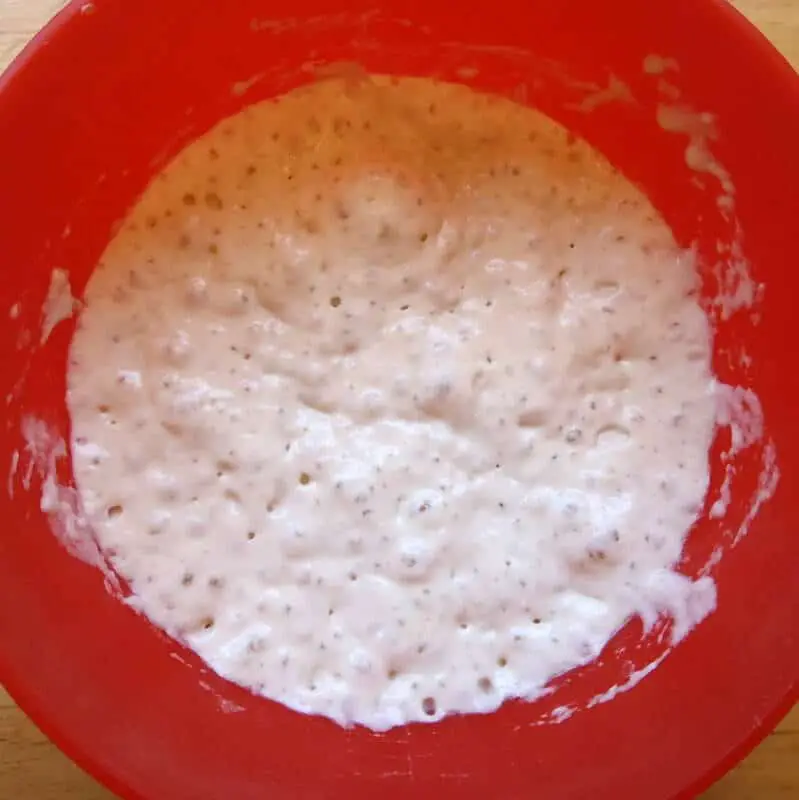Bread-making is an art that has been practiced for centuries. Over time, various techniques and ingredients have been developed to improve the texture, flavor, and appearance of bread. Two such techniques involve the use of pre-ferments: poolish and sourdough starter. While both serve to enhance the bread’s characteristics, they do so in distinct ways. This article delves into the nature of poolish and sourdough starter, exploring their effects on the baking process and the final product.
Poolish is a liquid (100% hydration) Polish pre-ferment using commercial yeast with no salt, yielding a milder and less sour bread. In contrast, sourdough starter relies on wild yeast and bacteria as its leavining agent, producing strong sourish bread flavors. While the use of commercial yeast in Poolish ensures consistent fermentation, Sourdough Starters offers diverse flavors and applications.
1. What is Poolish?
a. Origin and History
Poolish, as its name suggests, has its roots in Poland. It was in the Polish bakeries where this technique of pre-fermentation was first developed. However, its widespread popularity can be attributed to French bakers who adopted and refined the method, making it a staple in many classic French bread recipes.
b. How to make Poolish?

Poolish is essentially a wet sponge, characterized by its high hydration level. It is always a 100% hydration mixture, made by combining equal parts of flour and water by weight. No salt is added to the Poolish, similar to Biga and Sourdough Starter. To this mixture, a small quantity of commercial yeast is added, typically around 0.25% weight of flour. Unlike sourdough starters that rely on wild yeasts and bacteria from the environment, poolish uses store-bought yeast, ensuring a more predictable fermentation process.
Once mixed, the poolish is left to ferment, typically for a period ranging from 12 to 16 hours. This slow fermentation process allows for a deeper flavor development compared to straight dough method.
2. Comparative Analysis: Poolish vs. Sourdough Starter
a. Flavor Profile
Poolish: Breads made using poolish have a mild tanginess, attributed to the fermentation of the commercial yeast. The flavors are subtle, with a hint of nuttiness and a mild yeasty aroma.
Sourdough Starter: The flavor profile of sourdough is more robust. The presence of wild yeast and lactic acid bacteria in the starter results in the production of organic acids, giving sourdough its characteristic tangy flavor. The longer fermentation time also contributes to a deeper, more complex flavor profile.
b. Maintenance
Poolish: One of the main advantages of poolish is its low maintenance. It’s typically prepared a day before baking and does not require continuous feeding or care. Once it’s done fermenting, it’s mixed into the final dough.
Sourdough Starter: Maintaining a sourdough starter is a commitment. It requires regular feedings, often daily or every other day, to keep the culture active and healthy. The environment, including factors like temperature and humidity, can also affect the starter’s activity.
c. Consistency in Leavening (Commercial Yeast vs Wild Yeast)
Poolish: Poolish relies on the activity of commercial yeast for leavening. This ensures a consistent and predictable rise, making it a favorite among many bakers, especially those new to bread-making.
Sourdough Starter: The leavening in sourdough comes from the wild yeast captured from the environment. This natural leavening process can be less predictable, and the rise can vary based on the activity of the starter and environmental conditions.
d. Bulk fermentation and Proofing Time
Poolish: Given that poolish uses commercial yeast, the fermentation and rise times are typically shorter. Once the poolish is mixed into the final dough, the bulk fermentation can range from a few hours to overnight, depending on the recipe.
Sourdough Starter: Sourdough fermentation is a slower process. The dough can require extended bulk fermentation times, often ranging from 6 to 24 hours. This longer fermentation contributes to the development of the deep flavors characteristic of sourdough bread.
3. Considerations when Substituting Sourdough Starter with Poolish
a. Tweaking Hydration Levels

The hydration level of sourdough starters can vary, but many common starters maintain a 100% hydration, meaning equal parts water and flour.
Poolish is always made at 100% hydration, using equal weights of water and flour.
If the original recipe was designed for a sourdough starter with a hydration level different from 100%, adjustments to the water and flour quantities will be necessary when using poolish. This ensures the dough maintains the desired consistency.
b. Fermentation Time
Due to its reliance on wild yeast and bacteria, sourdough fermentation can be a longer process, often requiring extended bulk fermentation times, sometimes up to 12 hours or more.
Given its use of commercial yeast, poolish typically has shorter fermentation and final proofing times, roughly half that of bread made with sourdough starter.
When substituting sourdough with poolish, bakers might notice a reduction in the overall fermentation time. This can be advantageous for those looking for quicker results, but it’s essential to monitor the dough closely to avoid over-fermentation.
c. Flavor and Texture Considerations
Breads made with sourdough starter are known for their tangy flavor, a result of the organic acids produced during fermentation. The texture can also be chewier with a more open crumb structure.
While poolish contributes to a flavorful bread, it lacks the pronounced tang of sourdough. The bread’s texture might be similar in terms of softness and crumb, but the flavor profile will be milder and less sour.
Bakers should be aware that while the overall texture of the bread might remain similar, the characteristic tangy flavor of sourdough will be subdued when using poolish. Depending on personal preferences or the desired outcome, this might be seen as an advantage or a compromise.
In conclusion
Both poolish and sourdough starter offer unique advantages to the bread-making process. While poolish provides a quick and reliable way to enhance flavor and texture, sourdough starter brings a depth of flavor, natural leavening, and potential health benefits. Choosing between the two depends on the baker’s preference, the desired bread characteristics, and the time available for fermentation. Regardless of the choice, both methods celebrate the timeless tradition of bread-making and the magic of fermentation.

